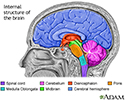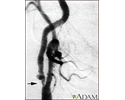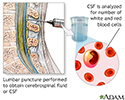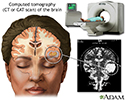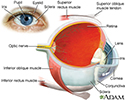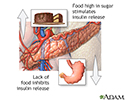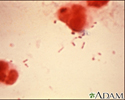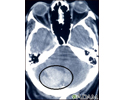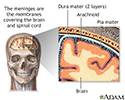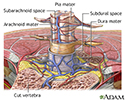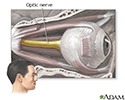Multimedia Gallery
Seizures
Having a brain seizure can be a terrifying experience. If you have a seizure, there was a problem with too much uncoordinated electrical activity in your brain.
In general, a seizure is when too many of your brain cells become excited at the same time. There are two different types of seizures, generalized and partial. With a generalized seizure, your brain has abnormal electrical activity on both sides of your brain. Partial seizures happen when electrical activity surges in one part of your brain.
Seizures can happen for many reasons:
It may be from high levels of salt or sugar in your blood; brain injury from a stroke or head injury brain problems you are born with or perhaps a brain tumor.
Dementia, such as Alzheimer's disease, high fever or illnesses or infections that hurt your brain. Illegal drug use or withdrawal from alcohol or drug use can cause seizures as well.
So, what are the signs that someone is having a seizure?
Some people with seizures may have simple staring spells, while others have violent, uncontrollable shaking and loss of consciousness. Some people will see flashing lights, others may hallucinate. Some people may have strange sensations, such as tingling, smelling an odor that isn't really there, or emotional changes.
Most people who have a seizure for the first time will go to the emergency room. The doctor will do tests to rule out medical causes, such as a stroke. You may have blood tests, CT or MRI scans of your head, or a spinal tap.
Treatment depends on the cause of your seizure. For example, if a seizure was caused by fever, treatment will focus on bringing the fever down.
Your doctor may send you home with some medicines to help you avoid having more seizures if there is reason to think you are at continued risk of seizures. You should get plenty of sleep and try to keep as regular a schedule as possible, and try to avoid too much stress.
Most people with seizures can have a very active lifestyle. Plan ahead for the possible dangers of a certain activity. Avoid any activity where loss of consciousness would be dangerous until it is clear that seizures are unlikely to occur again.
Seizures
Review Date: 4/16/2025
Reviewed By: Joseph V. Campellone, MD, Department of Neurology, Cooper Medical School at Rowan University, Camden, NJ. Review provided by VeriMed Healthcare Network. Also reviewed by David C. Dugdale, MD, Medical Director, Brenda Conaway, Editorial Director, and the A.D.A.M. Editorial team.
Animations
- Alzheimer disease
- Alzheimer disease
- Asperger syndrome
- Atherosclerosis
- Athetosis resulting from ba...
- Attention deficit hyperacti...
- Autism spectrum disorders
- Bladder function - neurolog...
- Brain components
- Cerebral aneurysm
- Cerebral palsy
- Cholesterol and triglycerid...
- Cluster headache
- Concussion
- Concussion
- Diabetes
- Epilepsy
- Epinephrine and exercise
- Erection problems
- Essential hypertension
- Feeling pain
- Hardening of arteries
- Head injury
- Herniated disk
- Herniated nucleus pulposus ...
- How to use a pill cutter
- Hypertension - overview
- Insomnia
- Migraine
- Multiple sclerosis
- Neck pain
- Nerve conduction
- Parkinson disease
- Sciatica
- Seizures
- Shingles
- Sleep disorders
- Spinal stenosis
- Stroke
- Stroke
- Stroke - secondary to cardi...
- Systemic lupus erythematosus
- Tension headache
- Understanding cholesterol r...
- Urinary incontinence
Illustrations
- 15/15 rule
- Active vs. inactive muscle
- Acupuncture
- Adult dermatome
- Alcoholic neuropathy
- Alpha-glucosidase inhibitors
- Alzheimer disease
- Amebic brain abscess
- Amyloidosis of the fingers
- Arterial plaque build-up
- Arterial tear in internal c...
- Arteries of the brain
- Atherosclerosis
- Atherosclerosis of internal...
- Autonomic Nerves
- Balance receptors
- Before and after hematoma repair
- Bicycle helmet - proper usage
- Biguanides
- Blood pressure
- Blood pressure check
- Blood test
- Blood test
- Bone graft harvest
- Brain
- Brain
- Brain and nervous system
- Brain herniation
- Brain structures
- Brain wave monitor
- Brainstem function
- Brudzinski's sign of meningitis
- Calories and fat per serving
- Carotid dissection
- Carotid duplex
- Carotid stenosis - X-ray of...
- Carotid stenosis - X-ray of...
- Carpal tunnel surgical procedure
- Carpal tunnel syndrome
- Cataract - close-up of the eye
- Cauda equina
- Cause of headaches
- Causes of secondary headache
- Central nervous system
- Central nervous system
- Central nervous system and ...
- Cerebellum - function
- Cerebral aneurysm
- Cerebral aneurysm
- Cerebrospinal fluid leak
- Cervical spondylosis
- Cervical vertebrae
- Cholesterol
- Cholesterol producers
- Circle of Willis
- Common peroneal nerve dysfu...
- Complex carbohydrates
- Compression fracture
- Compression of the median nerve
- Concussion
- Congenital toxoplasmosis
- Copper urine test
- Coronary artery blockage
- Craniotomy for cerebral shunt
- Creutzfeldt-Jakob disease
- Crossed eyes
- CSF cell count
- CSF chemistry
- CSF protein test
- CT scan
- CT scan of the brain
- Damaged axillary nerve
- DASH diet
- Developmental process of at...
- Diabetes and exercise
- Diabetes and nerve damage
- Diabetic blood circulation ...
- Diabetic emergency supplies
- Diabetic retinopathy
- Ear anatomy
- Effects of age on blood pressure
- Electromyography
- Endarterectomy
- Endocrine glands
- Enlarged view of atherosclerosis
- Exercise can lower blood pr...
- External and internal eye a...
- Eye
- Eye ultrasound
- Facial drooping
- Femoral nerve damage
- Fibromyalgia
- Fish in diet
- Food and insulin release
- Forward bend test
- Glaucoma
- Glossopharyngeal neuralgia
- Glucose in blood
- Glucose test
- Grand mal seizure
- Gray and white matter of th...
- Haemophilus influenzae organism
- Head injury
- Head trauma
- Headache
- Healthy diet
- Herniated disk repair
- Herniated lumbar disk
- Herniated nucleus pulposus
- Herpes zoster (shingles) - ...
- Herpes zoster (shingles) di...
- Herpes zoster (shingles) on...
- Herpes zoster (shingles) on...
- Herpes zoster (shingles) on...
- Herpes zoster (shingles) on...
- Herpes zoster (shingles) on...
- Herpes zoster (shingles) on...
- Herpes zoster (shingles) on...
- High blood pressure tests
- Hunger center in brain
- Hypothalamus
- Increased intracranial pressure
- Indications of head injury
- Insulin production and diabetes
- Insulin pump
- Insulin pump
- Intervertebral disk
- Intracerebellar hemorrhage ...
- Intracerebral hemorrhage
- Intracranial pressure monitoring
- Irregular sleep
- Kernig's sign of meningitis
- Kyphosis
- Late-stage syphilis
- Left cerebral hemisphere - ...
- Leukoencephalopathy
- Lifestyle changes
- Limbic system
- Lobes of the brain
- Location of whiplash pain
- Low blood sugar symptoms
- Lower leg muscles
- Lumbar puncture (spinal tap)
- Lumbar vertebrae
- Lumbar vertebrae
- Lyme disease
- Lyme disease - Borrelia bur...
- Lyme disease - erythema migrans
- Lyme disease organism - Bor...
- Meninges of the brain
- Meninges of the spine
- Migraine cause
- Migraine headache
- Monitoring blood pressure
- Motor nerves
- MRI of the brain
- MRI scans
- Multiple sclerosis
- Muscle cells vs. fat cells
- Muscle fatigue
- Muscle pain
- Muscular atrophy
- Myelin and nerve structure
- myPlate
- Neck pain
- Nerve biopsy
- Nerve conduction test
- Nerve supply to the pelvis
- Nervous system
- Neurofibromatosis I - enlar...
- Normal pupil
- Omega-3 fatty acids
- Optic nerve
- Pain of cluster headache
- Phytochemicals
- Pituitary gland
- Plaque buildup in arteries
- Prevention of heart disease
- Primary brain tumor
- Ptosis - drooping of the eyelid
- Radial nerve dysfunction
- Radiation therapy
- Retina
- Right cerebral hemisphere -...
- Role of the vagus nerve in ...
- Sacrum
- Saturated fats
- Sciatic nerve
- Sciatic nerve damage
- Scoliosis
- Scoliosis
- Scoliosis brace
- Shaken baby symptoms
- Shingles
- Signs of scoliosis
- Simple carbohydrates
- Skeletal spine
- Skull of a newborn
- Skull of an adult
- Sleep patterns in the young...
- Sleep studies
- Slit-lamp exam
- Soluble and insoluble fiber
- Spinal anatomy
- Spinal cord injury
- Spinal curves
- Spinal fusion
- Spinal stenosis
- Spinal stenosis
- Spinal tumor
- Spine supporting structures
- Stroke
- Subdural hematoma
- Subdural hematoma
- Substantia nigra and Parkin...
- Sulfonylureas drug
- Systemic lupus erythematosus
- Tension-type headache
- Thiazolidinediones
- Thoracic outlet anatomy
- Tibial nerve
- Tick - deer engorged on the skin
- Tick, deer - adult female
- Torticollis (wry neck)
- Trans fatty acids
- Transient Ischemic attack (TIA)
- Tympanic membrane
- Type I diabetes
- Ulnar nerve damage
- Ultrasound, normal fetus - ...
- Untreated hypertension
- Vascular headaches
- Ventricles of the brain
- Vertebra and spinal nerves
- Vertebra, cervical (neck)
- Vertebra, lumbar (low back)
- Vertebra, thoracic (mid back)
- Vertebrae
- Vertebral column
- Vertigo
- Visual acuity test
- Visual field test
- Vitamin B6 benefit
- Vitamin B6 source
- Voiding cystourethrogram
- Weight loss
- Whiplash
- Wrist anatomy
- X-linked recessive genetic ...
- X-linked recessive genetic ...
- X-linked recessive genetic ...
- X-ray
- Yo-yo dieting
Presentations
- Carotid artery surgery - series
- Carpal tunnel repair - series
- Craniotomy - series
- CSF oligoclonal banding - ...
- Lumbar spinal surgery - series
- Meningocele repair - series
- Microdiskectomy - series
- Monitoring blood glucose - ...
- Spinal fusion - series
- Spinal surgery - cervical -...
- Stroke - series
- Two person roll - series
- Ventriculoperitoneal shunt ...

 Bookmark
Bookmark









































































